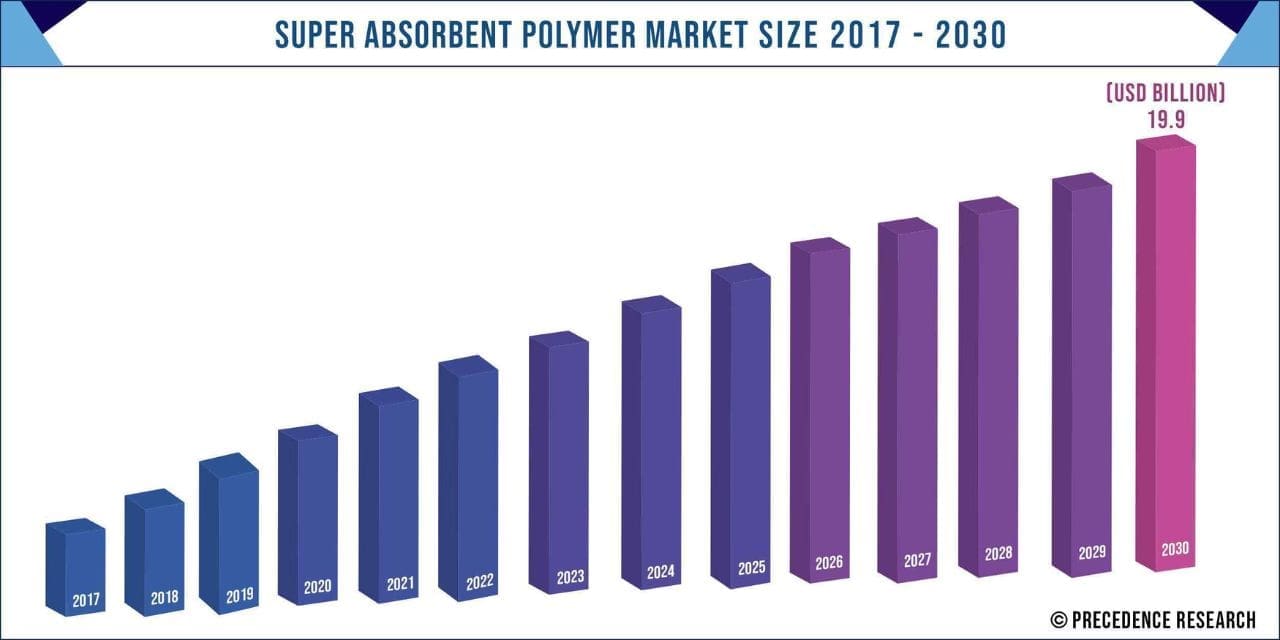The global super absorbent polymers market was valued at US$9.18 Bn in 2021. The market is expected to grow at a steady CAGR of 4.9% during the forecast period of 2021-2031. Super absorbent polymers have a wide range of utilities across multiple sectors. Their application in the production of disposable diapers will primarily drive market expansion for super absorbent polymers, accounting for nearly 76% of global sales.
Increasing use of super absorbent polymers in the production of disposable diapers, female hygiene products, and adult incontinence product among others will continue to boost sales of super absorbent polymers.
Rising awareness about personal hygiene and cleanliness, rising disposable income of consumers along with the high prevalence of urinary incontinence foster a positive growth environment for the market. Growing cases of urinary incontinence have prompted healthcare workers to develop incontinence solutions in partnership with manufacturers.
Also, increasingly favorable healthcare and reimbursement policies by governments across the world have instilled a willingness in the consumers to spend more on quality incontinence products. All these factors are expected to boost the market growth of super absorbent polymers.

“Apart from incontinence products, super absorbent polymers are finding applications in agriculture, construction, and packaging solutions. This will likely raise the sales of super absorbent polymers in the global market,” says an FMI analyst.
Key Takeaways:
- Disposable diapers account for 76% of the global sales of super absorbent polymers.
- Agriculture, construction, and packaging sectors increasingly use super absorbent polymers.
- Feminine hygiene products own a 7.8% market revenue share.
- China is predicted to account for 76% of the East Asia super absorbent polymers market shares over the forecast period.
- Super absorbent polymers market in India will rise to a 5.8% CAGR.
- Japan registered over 16% market share within East Asia in 2021.
- Brazil is expected to present substantial growth potential during 2021-2031.
Super Absorbent Polymers Market Regional Analysis
According to recent FMI reports, Asia Pacific is set to gain growth momentum in the super absorbent polymers market. Japan, China, and India are expected to lead the regional market growth. In 2021, China’s super absorbent polymers market grew by 3.9% on a year-on-year basis. Rising disposable income and increasing consumer spending on personal and hygiene care products contribute to making China one of the largest consumer bases of personal hygiene products.
As more than one-tenth of the world’s baby population is in China, disposable diapers are in high demand. This bodes well for the regional market.
Super absorbent polymers market in India is experiencing incredible growth. Driven by rising awareness about hygiene and cleanliness, the super absorbent polymers market demand is set to register a CAGR of 5.8% over the assessment period. High birth rate, immense population, and advancing economy are also contributing factors to market growth. Rising demand for feminine hygiene and baby products further propels the regional market to grow.
Japan accounted for over 16% of super absorbent polymers market sales in the past year. The country is considered one of the most important super absorbent polymer markets as it was here that the first super absorbent polymer was produced which later resulted in high adoption rates. Rising geriatric population has led to an increase in the number of urinary incontinence which, in turn, will boost Japan’s market growth.
Latin America presents substantial growth potential in the market. Brazil super absorbent polymers market is leading regional growth. Due to increasing awareness about menstrual hygiene super absorbent polymers market is witnessing significant growth in Brazil.

